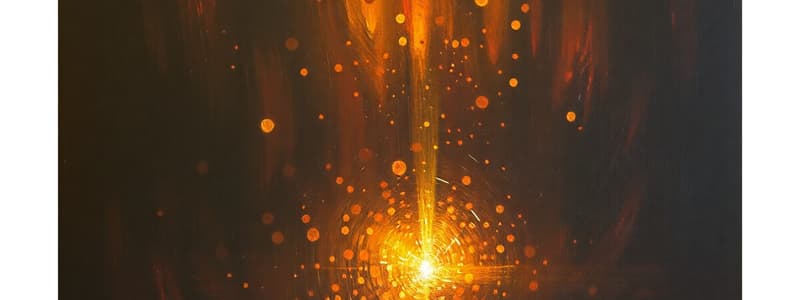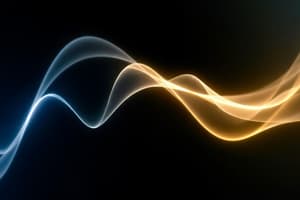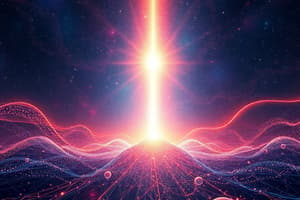Podcast
Questions and Answers
What process describes the redirection of light rays by particles in a medium?
What process describes the redirection of light rays by particles in a medium?
- Refraction
- Absorption
- Scattering (correct)
- Transmission
In the context of the photoelectric effect, what does 'h' represent in the equation $E=hv$?
In the context of the photoelectric effect, what does 'h' represent in the equation $E=hv$?
- The frequency of the light
- Planck's constant (correct)
- The energy of the photon
- The velocity of light
Which of the following is NOT a primary application of lasers?
Which of the following is NOT a primary application of lasers?
- Medical procedures
- Data storage
- Basic illumination (correct)
- Long-distance communication
What term describes the passage of light through a medium without being absorbed?
What term describes the passage of light through a medium without being absorbed?
What phenomena demonstrates that light can behave as particles (photons)?
What phenomena demonstrates that light can behave as particles (photons)?
What is the approximate speed of electromagnetic radiation in a vacuum?
What is the approximate speed of electromagnetic radiation in a vacuum?
Which of the following best describes the relationship between wavelength and frequency of electromagnetic radiation?
Which of the following best describes the relationship between wavelength and frequency of electromagnetic radiation?
Which phenomenon demonstrates that light has wave-like properties?
Which phenomenon demonstrates that light has wave-like properties?
What is the process where light bends as it passes from one medium to another?
What is the process where light bends as it passes from one medium to another?
What is the range of wavelengths in nanometers for visible light?
What is the range of wavelengths in nanometers for visible light?
If two light waves combine and create a larger wave, it is called:
If two light waves combine and create a larger wave, it is called:
What property of light is responsible for a red object appearing red?
What property of light is responsible for a red object appearing red?
Which of the following is a correct measure of frequency?
Which of the following is a correct measure of frequency?
Flashcards
Absorption of Light
Absorption of Light
The process by which matter absorbs light energy, often converting it into heat or other forms of energy.
Transmission of Light
Transmission of Light
The passage of light through a medium without being absorbed or scattered.
Scattering of Light
Scattering of Light
The redirection of light rays by particles in a medium. This can result in diffuse reflection or Rayleigh scattering.
Photoelectric Effect
Photoelectric Effect
Signup and view all the flashcards
Photon Energy
Photon Energy
Signup and view all the flashcards
Electromagnetic Spectrum
Electromagnetic Spectrum
Signup and view all the flashcards
Wavelength (λ)
Wavelength (λ)
Signup and view all the flashcards
Frequency (ν)
Frequency (ν)
Signup and view all the flashcards
Refraction
Refraction
Signup and view all the flashcards
Reflection
Reflection
Signup and view all the flashcards
Diffraction
Diffraction
Signup and view all the flashcards
Interference
Interference
Signup and view all the flashcards
Color
Color
Signup and view all the flashcards
Study Notes
Electromagnetic Spectrum
- Light is a form of electromagnetic radiation, a transverse wave.
- Electromagnetic waves are composed of oscillating electric and magnetic fields that propagate through space at the speed of light (approximately 3 x 10⁸ m/s).
- The electromagnetic spectrum encompasses a broad range of wavelengths and frequencies, including radio waves, microwaves, infrared radiation, visible light, ultraviolet radiation, X-rays, and gamma rays.
- Different types of electromagnetic radiation have different properties and applications.
Properties of Light
- Light exhibits both wave-like and particle-like characteristics, a phenomenon known as wave-particle duality.
- As a wave, light demonstrates phenomena such as interference and diffraction, which can be explained by Huygens' principle.
- Light can be polarized, meaning that its electric field oscillates in a specific direction.
- Light interacts with matter in various ways, including reflection, refraction, absorption, and scattering.
- The color of light is determined by its wavelength.
Wave Characteristics
- Wavelength (λ): the distance between two consecutive crests or troughs of a wave. Measured in meters or nanometers (nm).
- Frequency (ν): the number of waves that pass a given point per unit time. Measured in Hertz (Hz).
- Amplitude: the maximum displacement of a wave from its equilibrium position.
- Speed (c): the rate at which a wave travels.
Behavior of Light
- Reflection: the bouncing of light rays off a surface. The angle of incidence equals the angle of reflection.
- Refraction: the bending of light as it passes from one medium to another. This bending depends on the refractive index of the media.
- Diffraction: the spreading of light waves as they pass through an opening or around an obstacle. This effect is more pronounced when the opening is comparable in size to the wavelength.
- Interference: the combination of two or more light waves, creating either constructive or destructive interference.
- Polarization: the alignment of the electric field vectors of light waves.
Visible Light and Color
- Visible light is a small portion of the electromagnetic spectrum.
- The visible spectrum spans wavelengths approximately from 400 nm (violet) to 700 nm (red).
- Objects appear colored because they absorb certain wavelengths of light and reflect others.
- Mixing different wavelengths of light can create different colors. This is demonstrated in additive color mixing (e.g., on computer screens) and subtractive color mixing (e.g., in printing).
Interaction of Light with Matter
- Absorption: the process by which matter absorbs light energy, often converting it into heat or other forms of energy.
- Transmission: the passage of light through a medium without being absorbed or scattered.
- Scattering: the redirection of light rays by particles in a medium. This can result in diffuse reflection or Rayleigh scattering.
Applications of Light
- Optical instruments (e.g., microscopes, telescopes, cameras) utilize the properties of light.
- Lasers produce highly coherent light with applications in medicine, communication, and industry.
- Fiber optics transmit light signals over long distances with high speed.
- Spectroscopy analyzes the interaction of light with matter to reveal information about its composition and properties.
- Lighting technologies use various light sources for illumination.
Photoelectric Effect
- Light can also behave as particles called photons.
- The photoelectric effect describes the emission of electrons from a material when light shines on it.
- The energy of a photon is proportional to its frequency (E = hv), where h is Planck's constant. This demonstrates the particle nature of light in this context.
- Different frequencies of light have different effects on the emission of electrons, as demonstrated in the experiment by Einstein.
Studying That Suits You
Use AI to generate personalized quizzes and flashcards to suit your learning preferences.




